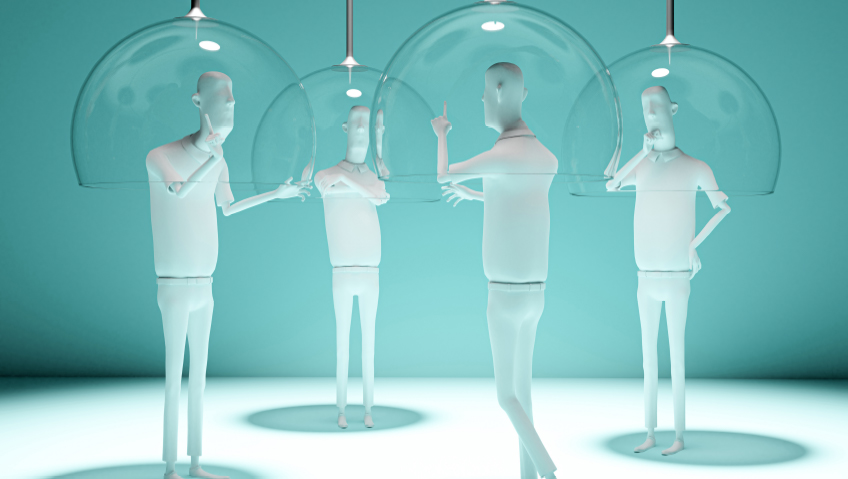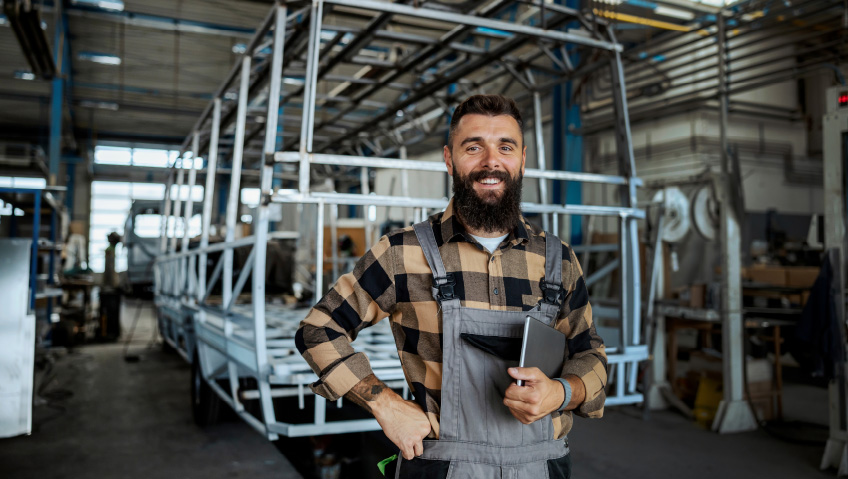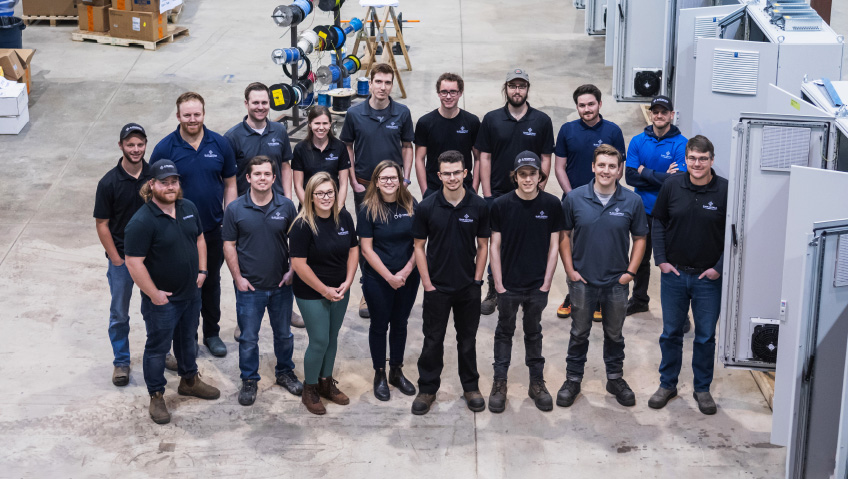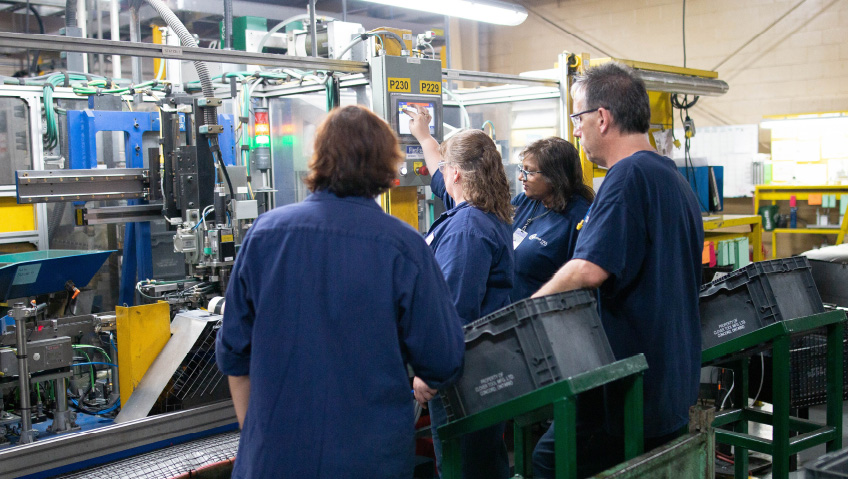When it comes to creating optimally functioning public spaces in the time of COVID-19, the entire world appears to be competing. In this feature, we look at how manufacturers can help improve safety within shared spaces.
In the late 1960s, the famous anti-war advocacy group Another Mother for Peace (AMP) had a memorable slogan displayed on placards and clothing at nearly every opposition rally. It said ‘War is not healthy for children and other living things.’ Ironically, it took the war on COVID-19 to make us realize at many of our public spaces are also not healthy for living things. Today, the North American manufacturing industry is stepping up to help create healthier spaces for people to work and gather.
Underscoring the human ability to transcend challenges through creativity, fabricators specializing in furniture, technology, and everything else it takes to make public spaces function more safely during the pandemic are currently looking at ways to adapt and improve their products to answer the demand for social distancing and personal protection in public. As always, early adopters in the field are in the midst of an unprecedented boom.
There are several universal points that solution providers must consider when rethinking the safety of people in high-density indoor and outdoor spaces. These mainly include the number of people who can be safely allowed into a public space at any one time, the physical distance between those people, the air and light quality of indoor spaces, cleanliness, and the number of touch or contact points that exist for the building or outdoor space to function properly.
Technology manufacturer XOVIS points out that controlling the flow of people is the first step in managing social distancing in busy public spaces. To this end, it collaborated with Cologne-based software company dimedis, which recently launched ViCo, a digital visitor admission control product that runs on XOVIS software.
The easily programmed, automatic ‘people counter’ is used to control visitor access by counting and managing the number of people legally allowed within a space. Features include a traffic-light style stop-and-go system that can, with permission, collect and analyze data on the behaviour of occupants. The product received the business magazine WirtschaftsWoche and Deutsche Telekom’s Digital Champions Award in 2020.
XOVIS also introduced several hardware and software solutions to control general contact in retail spaces as well as in airports and other transportation hubs. Its Passenger Tracking System employs 3D sensors that unobtrusively track and count passengers. This information is then processed by its XOVIS Airport Software, identifying and alerting managers to any issues related to crowding, distancing, and occupancy within any of the designated public areas. The sensors also employ artificial intelligence (AI) to detect people who are not wearing face masks and can spot and remove employees from calculations when analyzing data.
Manufacturers’ research and development teams are not only transforming interiors with novel technology and furniture made to enforce two-meter distancing in all directions, but outside spaces are also being reimagined. The design team of Kosovo-based Architecture for Humans recently shared a seating plan that permits about forty-eight single stools to be slotted between heavy floor tiles at two-metre intervals. This gives each seat a generous radius of free space in which people can enjoy reading books, have a snack, listen to music, or just kill time while grabbing some fresh air, knowing that they are at a safe distance from their neighbours. The seats are easily installed, rather simple to manufacture, and an ideal feature for modern, open plazas with heavy tiling.
One of the world’s most memorable recent initiatives of social distancing was at The Flaming Lips’ rock concert’s ‘space bubble’ approach to COVID-19. After performing inside one of these zip-up plastic spheres last year, the band decided to provide everyone in their audience with a bubble at its 2021 performance for around three hundred fans at The Criterion theatre in Oklahoma City.
Each bubble was fitted with a speaker for clear sound, and water and towels were also provided. The disinfection process before and after use was stringent, and there were signs inside that fans could flash at assistants to request a break. The bubbles were said to be safely oxygenated for just over an hour with three occupants inside and could easily be resupplied using a leaf blower. Further ‘space bubble’ concerts are surely on the way.
Further afield, Wayne Head of British architecture firm Curl la Tourelle Head, provided a design for London, England’s first pop-up school, based on a sturdy tent layout. The classrooms are geared toward social distancing and ensuring that children have enough fresh air. The basic versions are great for use in summer, but the range also offers more sophisticated, insulated units that can function in all weather, year-round.
“We are confident that we have the solution to help schools increase their capacity and bring back more pupils while still following the social distancing rules and ensuring a safe environment for the children and staff,” Head stated on the Curl la Tourelle Head website in June last year.
Closer to home, CNBC has reported that the need to curb the spread of COVID-19 is fortifying the argument for employing more biophilic design in public spaces. Edward O. Wilson, who coined the term in his 1984 book ‘Biophilia,’ defined it as “the urge to affiliate with other forms of life.”
While current safety measures like dividing barriers may not remain compulsory forever, overall air and water standards are expected to rise permanently, as is the trend of enhancing interiors with the healthful perks provided by plants, fresh air, natural light, and other earthy elements.
One product set to transform traditional office lighting is low thermal emissivity glass (E-glass). It provides significantly improved insulation and, as a result, much better energy efficiency in buildings with large windows. Social distancing has also increased the need for optimizing the use of outdoor spaces. As a result, innovative office spaces and meeting areas are popping up in traditionally under-utilized spots like rooftops.
With overall wellness becoming increasingly imperative in the workplace, companies are beginning to offer staff custom-made, technology-free spaces and meditation rooms like those at Nelson Worldwide’s offices in Philadelphia, Pennsylvania. The global architecture leader and brand strategist also predicts more cafeterias and cafés setting up outdoors and an increase in virtual cafés and ghost restaurants or ‘cloud’ kitchens that deliver food via third-party contributors. Naturally, manufacturers are called upon to come up with materials and methods that will optimize personal protection, food safety through advanced packaging, and the safety of those using designated spaces.
A great example of the responsibility that now rests on the manufacturing industry to produce smart, touch-free, and social distancing design elements for public spaces is Chicago’s new Fulton East on 215 N. Peoria Street in the Fulton Market District. Driven by the outbreak of COVID-19, the design of this next-generation building gives us a hint at what more manufacturers could soon be offering. Arguably one of the world’s first new builds adapted to deal specifically with a health crisis such as COVID-19, Fulton East includes modern safety elements such as bathrooms painted in microbicidal paint claimed to wipe out around 99.9 percent of disease-causing bacteria within about two hours of it settling on painted areas.
Apart from adopting hands-free navigation for everything from faucets to access points and thermal scanning devices, the building also features the foot-activated elevator call button, Toe-To-Go (T2G), system by Canadian outfit, MAD Elevator Inc. According to Forbes, the Fulton East is making history as the first new building to house these elevators. There is also a marked move toward using specialized alloys on metal surfaces that are frequently touched. Copper is scientifically proven to be less hospitable to viruses than materials like stainless steel or plastic, making it the smarter choice.
Considering how COVID-19 and social distancing will affect where and how people choose to set up shop, establish offices, and gather in the future, things will change. Bob Wislow, chairman and chief executive officer of Fulton East’s development company, Parkside Realty, Inc., hinted in Forbes magazine at a marked move away from traditional high-rise buildings toward smaller ones. This trend could bring about increased demand for more health-conscious and specialized designs.
Scientists deem the movement toward biophilia in design to be a giant leap in the right direction, because the average urban American can rarely be found outdoors, and the statistics are troublesome. People are estimated to be indoors over eighty percent of the time, and health issues from being in contact with raised pollution levels inside highly-populated buildings. Such toxic indoor pollution can be caused by paint fumes, cleaning chemicals, smoke, dust, and more.
Manufacturing goods that embrace nature and biophilic design is increasing by the day. “COVID-19 has accelerated the healthy buildings movement,” Joseph Allen, director of the Healthy Buildings Program at the Harvard T.H. Chan School of Public Health told CNBC. “Every sector is now talking about what they need to do for health in the building, for COVID-19, infectious disease transmission and beyond,” he added.






